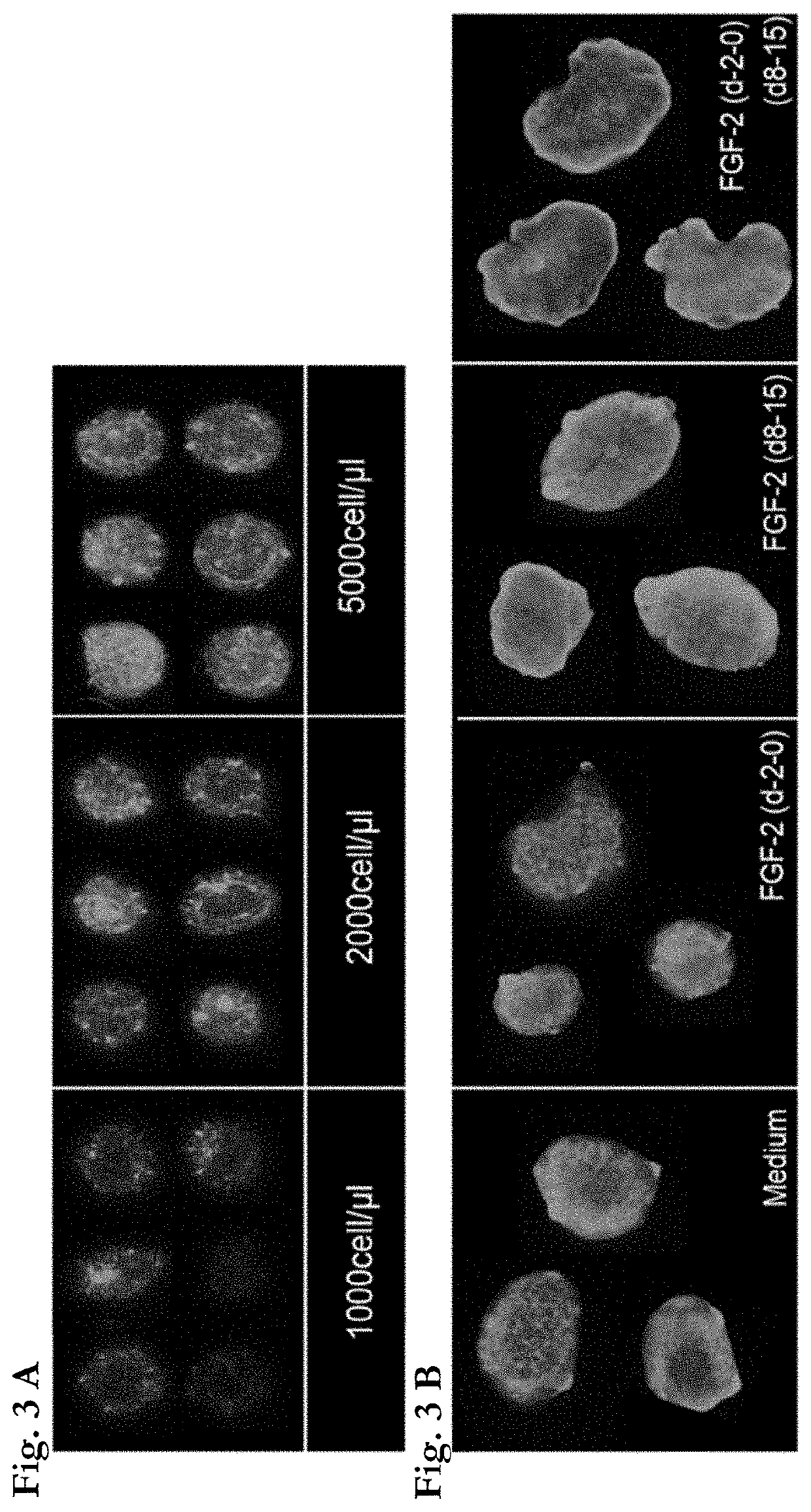Methods of producing bioengineered neuronal organoids (BENOS) and uses thereof
a bioengineered neuronal organ and organoid technology, applied in the field of bioengineered neuronal organoids and uses thereof, can solve the problems of limiting the utility of existing neuronal organoids, affecting the survival rate of organoids, and displaying high phenotypic variability of organoids, so as to improve the survival rate, protect the organ, and improve the effect of regeneration
- Summary
- Abstract
- Description
- Claims
- Application Information
AI Technical Summary
Benefits of technology
Problems solved by technology
Method used
Image
Examples
example 1
ion of the Protocol for Production of BENOs
[0233]The following studies were performed in order to optimize the disclosed protocols for neural induction, NPC amount, and neuronal differentiation. The resulting data permitted establishing of an optimal protocol for producing BENOs (Example 2).
[0234]Neural Induction Optimization
[0235]In initial attempts, single SMAD pathway inhibition (using noggin) was employed to elicit neural induction, along with the addition of retinoic acid (RA). In the present study, it was tested whether dual SMAD signaling pathway inhibition using noggin and SB431542 during the neural induction phase (days 0-8) might further enhance neurogenesis, e.g., at day 28. Accordingly, NCM containing only noggin, or NCM containing noggin and SB431542, were each investigated. Dual SMAD inhibition was clearly observed to be advantageous as to the resulting amount of maturing neurons, as demonstrated by immunofluorescence analysis (FIG. 2A) and transcript analysis of PAX6 ...
example 2
Protocol for Generating Human Bioengineered Neuronal Organoids (BENOs)
[0247]The following studies establish an optimal protocol for producing human bioengineered neuronal organoids (BENOs).
[0248]Materials
[0249]The materials used in these experiments are the same as those used in Example 1.
[0250]Stock Solutions (−20° C.)
[0251]The stock solutions used in these experiments are the same as those used in Example 1.
[0252]Working Solutions (4° C.)
[0253]The EDTA 0.5 mM solution, the Matrigel 1:30 solution, the TeSR™-E8™ medium, and the Basal medium used in these experiments are the same as those used in Example 1.
[0254]Neural Commitment Medium (NCM)
[0255]Basal medium (50 ml) supplemented with 10 μM SB 431542 (50 μl), 50 ng / ml noggin (10 μl), and 1 μM RA (5 μl).
[0256]Neural Progenitor Expansion Medium (NPEM)
[0257]Basal medium (50 ml) supplemented with 10 ng / ml FGF-2 (50 μl) and 5 ng / ml TGFB1.
[0258]Neural Differentiation Medium (NDM)
[0259]Basal medium (50 ml) supplemented with 2.5 μM DAPT (1....
example 3
ughput Transcriptomic Analysis of BENOs
[0275]To characterize the cell types arising during the production of BENOs tissues at different time points (e.g., days −1, 0, 3, 8, 15, 28, 40, 50 and 60), the cells were submitted to RNAseq analysis; 3-6 tissues per time point).
[0276]First, the differentiation state of the cells during the time course of cell cultivation was tested. As expected, the stem cell markers NANOG and POUF5A1 were highly expressed at day −1 and day 0, but 3 days upon neural induction, the expression of these markers was significantly diminished. In contrast, SOX2, which is both a stem cell marker and also a NPC marker, did not show any decrease at these time points, but reached a maximum expression at day 15 along with other neuroectodermal and NPC markers. These data are consistent with the known proliferative effects of FGF-2. Most neuronal structural markers (MAP2, MAPT, NFASC, TUBA1A) increased significantly by days 28-40. Once neurogenesis was complete, gliogen...
PUM
 Login to View More
Login to View More Abstract
Description
Claims
Application Information
 Login to View More
Login to View More - R&D
- Intellectual Property
- Life Sciences
- Materials
- Tech Scout
- Unparalleled Data Quality
- Higher Quality Content
- 60% Fewer Hallucinations
Browse by: Latest US Patents, China's latest patents, Technical Efficacy Thesaurus, Application Domain, Technology Topic, Popular Technical Reports.
© 2025 PatSnap. All rights reserved.Legal|Privacy policy|Modern Slavery Act Transparency Statement|Sitemap|About US| Contact US: help@patsnap.com



